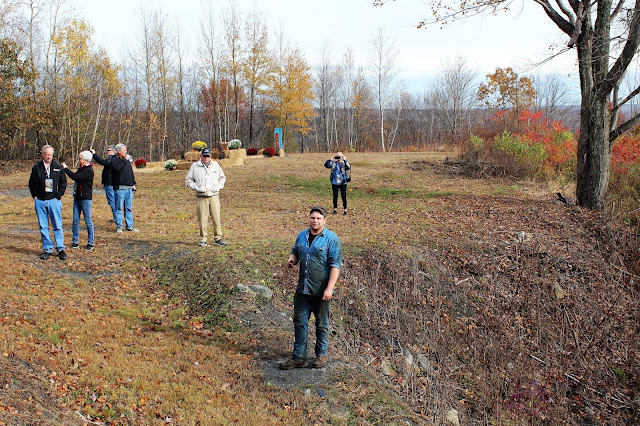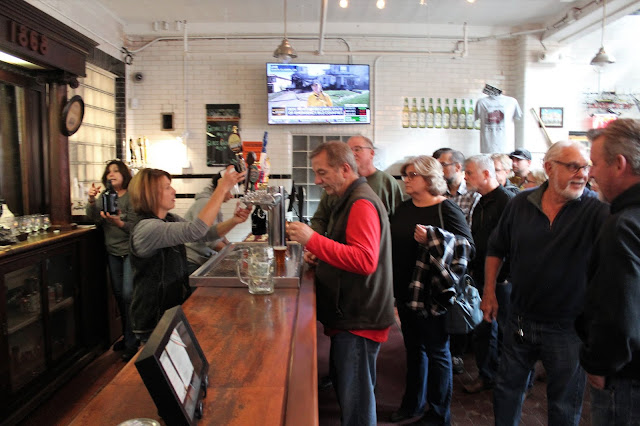After attending the very enjoyable
inaugural Corvette Racing Weekend in 2016, we were not able to repeat as the event was moved to the AACA Museum subsequently and held too late in the year for us to participate with our Corvette, which goes into storage each year on November 1. However, this year the Weekend, organized by the National Corvette Museum, was scheduled for late October so all was good again.
After an easy drive from Ottawa to Hershey and we checked into the hotel, which was directly next to the AACA Museum. We then drove out, following a Corvette with Minnesota plates, and attended a "Meet and Greet" at the nearby and excellent Tröegs Brewery, where we registered and picked up our information package. We joined a nice couple who had driven up from South Carolina and had dinner and some fine beers including my now-favourite US craft beer, a double bock (8.2%) called Troegenator.
After breakfast on Friday morning, we assembled in front of the Museum for the planned Poker Run, which had about 20 cars participating. We each got our first two cards for a poker hand (both of us had a pretty good start) and then we set out, heading north on I-81 towards Minersville, where we exited the Interstate. Taking some smaller roads, we were soon in Ashland, Pennsylvania and the Pioneer Tunnel Coal Mine.



>
Operated by the Philadelphia and Reading Coal and Iron Company from 1911 to 1931, the Pioneer Colliery was reopened as a museum in 1962. It is drilled straight into the side of Mahanoy Mountain and you get a rather jolting ride on a mine car that travels about 1800 feet. The guides were all retired miners who had a good line of patter. One of them was quite a bit younger and had only worked underground in 2001, when he had left and become a teacher. He was also a good singer and took out his guitar and performed a song about bootleg miners in Shamokin, something quite unexpected 400 feet underground.



We learned a great deal about life in the mines, which sounded pretty brutal, and how nobody could go home at the end of the workday unless 400 tons of coal had been taken out that day. The mules used to pull the carts were company property and treated better than the miners. There were plenty of rats underground and the miners even fed them as they provided a kind of early warning system as they are very sensitive to seismic shifts that could indicate a mine collapse. Coal has some specialized uses in steelmaking and even water filters but its time as a power source is gone. This region of 480 square miles contains most of the hard anthracite coal in the world. Anthracite is considered the highest quality coal due to its purity.


Before descending into the tunnel, we enjoyed an extremely bumpy five minute ride up the mountain in cars pulled along by a little narrow gauge steam engine, the Henry Clay, which gave us a view of the scenic valley to the left and a massive strip mine to the right. The Henry Clay was built in 1927 in Wilkes-Barre, Pennsylvania at the Vulcan Iron Works. The engineer of the train told us about "bootleg" mining during the Great Depression as he pointed out a replica. The mines were no longer economical to operate and were closed but local now-unemployed miners came up the mountain to dig for coal to sell. This was company property so it was theft but given the situation at the time eventually a deal was worked out allowing miners to dig for a small royalty.
 |
| Replica of a bootleg mine |
 |
| Strip mine tailings |
After this very interesting visit, and turning in our poker hands (which were not very good now!), the formal part of the morning's program was over. A recommendation was to drive to Pottsville and visit the
Yuengling Brewery, the oldest brewery still operating in the United States. The drive was only half an hour, taking us through Frackville, where we have stopped for gas on I-81 without ever exploring anything off the main highway. US 61 South was a terrific drive through Fall colours as we headed into Pottsville.
Pottsville was a bustling place but we found the brewery pretty easily. It had been established in 1829 and by virtue of continuing to exist (even managing to survive Prohibition by switching to dairy products) it has now come to be seen in the same fashionable light as modern craft breweries. When David Gottlieb Yuengling came to Pottsville it was because of the thriving coal mines and an ideal place to start a brewery.




The building, which was built in 1831 to replace the original Eagle Brewery that was opened in 1829 but burned down, is located on a steep street which actually has a spring further up the hill, although it is now too small to meet the demands of the brewery. The 1831 facility is not the only Yuengling brewery as the company purchased a former Stroh's Brewery in Tampa, Florida in 1999, and also opened a modern brewery not far from Pottsville in nearby Port Carbon in 2000 to meet demand. Yuengling is ranked as the 6th largest brewery in the United States, with production of around 3 million barrels per year.
 |
| An obvious advantage of building a brewery in Pottsville was that there were plenty of miners to dig out your lagering tunnels. |

 |
| Where the brewery workers used to have their breaks...looks like a German Kneipe (pub)! |

 |
| The machine shop, which made us think Yuengling never threw anything away since 1831 |
 |
| The bottling/canning line allows for 910 cans per minute to be filled |
After an enjoyable tour we had the chance to sample some beers, including the latest, a collaboration between Hershey and Yuengling: a Chocolate Porter that will be sold for a limited time. After our tour, we went to one of the recommended restaurants in the town,
Roma Pizza, and enjoyed some excellent Neapolitan-style pizza from their wood-burning oven.
When we parked the car we had not realized that we were directly opposite the boyhood home of noted American novelist John O'Hara (1905-1970), many of whose works (involving sex and alcohol and angry people and social climbing) were turned into films in the 1960s. He is more famous now for short stories but it can be said that his reputation is fading into obscurity. In his stories in t
he New Yorker magazine "Gibbsville" stands in for Pottsville.
Our return to Hershey was delayed on I-81 due to some kind of accident but we came back on some sideroads after getting off the highway. We then returned to the AACA Museum for a buffet dinner and the chance to hear Doug Fehan, Corvette Racing's Program Manager, along with Tommy Milner, driver of the No. 4 C7-R, talk about the Le Mans race, which was a bust for Corvette, as the No. 64 car was hit by a Porsche early on and was out of the race while No. 63 was damaged after it was spun late in the race and was classified 9th at the end. A disappointing end for the C7-R at the end of is Le Mans career.






































No comments:
Post a Comment